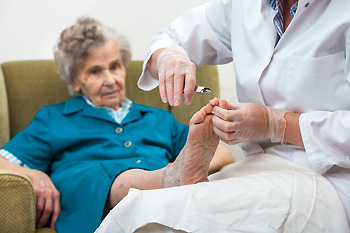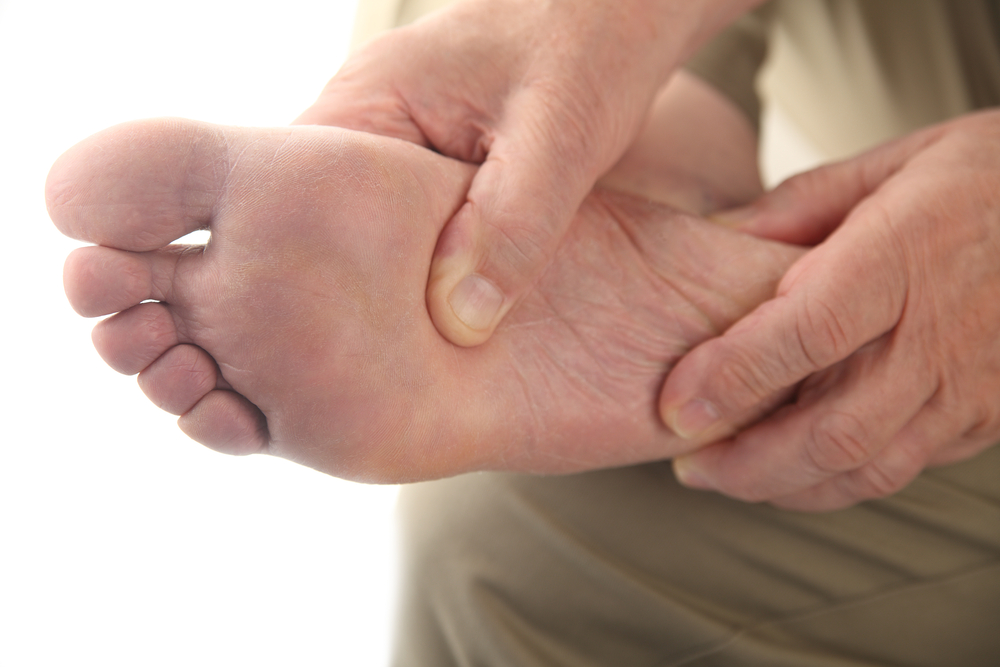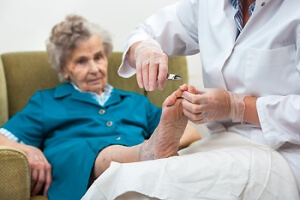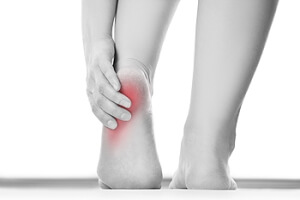
What Happens to Feet During Pregnancy?
 For pregnant women, the general health of the feet may be affected. The additional weight gain may cause the feet to become bloated, and has been known to alter some women’s sense of gravity. The alignment and posture in the body may change, and the feet may become affected as a result of the differences in standing and walking that many women endure. Becoming flat-footed is a common ailment that may affect many pregnant women. The arches may temporarily disappear as a result of the pressure the feet must withstand from the additional weight. Additionally, edema, or water retention, is a common condition that many pregnant women experience, and this typically occurs as a result of the blood becoming thicker during the pregnancy. There are several ways to partially alleviate any discomfort that is often associated with edema. These may include elevating your feet as often as possible, eliminating salt from your diet, and stretching the feet, which may enhance the general health of the body. If you have concerns about the effects of pregnancy on the feet, please consult with a podiatrist for additional information.
For pregnant women, the general health of the feet may be affected. The additional weight gain may cause the feet to become bloated, and has been known to alter some women’s sense of gravity. The alignment and posture in the body may change, and the feet may become affected as a result of the differences in standing and walking that many women endure. Becoming flat-footed is a common ailment that may affect many pregnant women. The arches may temporarily disappear as a result of the pressure the feet must withstand from the additional weight. Additionally, edema, or water retention, is a common condition that many pregnant women experience, and this typically occurs as a result of the blood becoming thicker during the pregnancy. There are several ways to partially alleviate any discomfort that is often associated with edema. These may include elevating your feet as often as possible, eliminating salt from your diet, and stretching the feet, which may enhance the general health of the body. If you have concerns about the effects of pregnancy on the feet, please consult with a podiatrist for additional information.
Pregnant women with swollen feet can be treated with a variety of different methods that are readily available. For more information about other cures for swollen feet during pregnancy, consult with one of our podiatrists from Apple Podiatry Group. Our doctors will attend to all of your foot and ankle needs.
What Foot Problems Can Arise During Pregnancy?
One problem that can occur is overpronation, which occurs when the arch of the foot flattens and tends to roll inward. This can cause pain and discomfort in your heels while you’re walking or even just standing up, trying to support your baby.
Another problem is edema, or swelling in the extremities. This often affects the feet during pregnancy but tends to occur in the later stages.
How Can I Keep My Feet Healthy During Pregnancy?
- Wearing orthotics can provide extra support for the feet and help distribute weight evenly
- Minimize the amount of time spent walking barefoot
- Wear shoes with good arch support
- Wear shoes that allow for good circulation to the feet
- Elevate feet if you experience swelling
- Massage your feet
- Get regular, light exercise, such as walking, to promote blood circulation to the feet
If you have any questions please feel free to contact our offices located in Arlington Fort Worth, And Flower Mound, TX . We offer the newest diagnostic and treatment technologies for all your foot and ankle needs.
Pregnancy and Foot Health
Many pregnant women complain about foot pain while they are expecting. Foot pain can primarily be caused by weight gain and hormonal changes taking place in the body. By understanding how pregnancy impacts the health of a woman's feet, a pregnant woman can take action to keep her feet as healthy and comfortable as possible.
Because a woman's weight changes during pregnancy, more pressure is brought to bear on both the legs and the feet. This weight shift can cause two major foot problems: over-pronation, also known as flat feet, as well as edema, which is swelling of the feet. Over-pronation occurs when the arch of the foot flattens, causing the foot to roll inwards when the individual is walking, and can aggravate the plantar fascia tissues located along the bottom of the feet. If these tissues become inflamed, a pregnant woman can experience pain in the heel of the foot as well as severe foot pain while walking or standing. Swelling of the feet, or edema, often occurs in the later stages of pregnancy. It is caused by slow circulation and water retention, and may turn the feet a light purple color.
To keep feet in good health and prevent over-pronation, pregnant women should avoid walking barefoot and be sure they are wearing shoes that offer good arch support. A device known as an orthotic can be added to regular footwear in order to provide additional support for the feet during pregnancy. Any expectant mother whose feet hurt should first check to see if the shoes she is wearing are old, worn out and not offering the proper support necessary for distributing the weight of her body during pregnancy.
To treat edema of the feet, a good start is to wear quality footwear which offers support and good circulation. Keep feet elevated whenever possible by using a foot stool while seated. Stay well hydrated by drinking plenty of water to prevent water retention in the feet. Any swelling that occurs in only one foot should be examined as soon as possible by a doctor.
Good foot health during pregnancy can help expectant mothers avoid foot pain that leads to other health problems. Massaging the feet and doing regular gentle exercise like walking aids foot health by contributing to good circulation. Supportive shoes are also a good investment that will support foot health during pregnancy.
The Importance of Proper Foot Care in Elderly People
 One of the best things that most people can do for their feet is to purchase shoes that fit comfortably. This is especially true for elderly people, who may be concerned about a loss of cushioning the feet may experience as the aging process progresses. Shoes that put pressure on the feet are best to be avoided such as high heels, which may possibly cause uncomfortable foot conditions such as corns. If you already have an existing case of bunions, wearing shoes that apply pressure on the feet could cause this condition to become worse. The importance of properly measuring the feet is necessary in older patients and this may possibly accommodate for the feet getting wider, which is common in elderly people. If the majority of the day is spent in a sitting position, it’s beneficial to frequently walk and stretch the legs, which may improve circulation. If the skin on the heels should appear dry and cracked, utilizing a good moisturizer will not only feel good, but will positively affect the general health of the foot. If you have questions and would like additional information about how to take care of elderly feet, it’s suggested to speak with a podiatrist who can provide the necessary answers.
One of the best things that most people can do for their feet is to purchase shoes that fit comfortably. This is especially true for elderly people, who may be concerned about a loss of cushioning the feet may experience as the aging process progresses. Shoes that put pressure on the feet are best to be avoided such as high heels, which may possibly cause uncomfortable foot conditions such as corns. If you already have an existing case of bunions, wearing shoes that apply pressure on the feet could cause this condition to become worse. The importance of properly measuring the feet is necessary in older patients and this may possibly accommodate for the feet getting wider, which is common in elderly people. If the majority of the day is spent in a sitting position, it’s beneficial to frequently walk and stretch the legs, which may improve circulation. If the skin on the heels should appear dry and cracked, utilizing a good moisturizer will not only feel good, but will positively affect the general health of the foot. If you have questions and would like additional information about how to take care of elderly feet, it’s suggested to speak with a podiatrist who can provide the necessary answers.
Proper foot care is something many older adults forget to consider. If you have any concerns about your feet and ankles, contact one of our podiatrists from Apple Podiatry Group. Our doctors can provide the care you need to keep you pain-free and on your feet.
The Elderly and Their Feet
As we age we start to notice many changes in our body, but the elder population may not notice them right away. Medical conditions may prevent the elderly to take notice of their foot health right away. Poor vision is a lead contributor to not taking action for the elderly.
Common Conditions
- Neuropathy – can reduce feeling in the feet and can hide many life-threatening medical conditions.
- Reduced flexibility – prevents the ability of proper toenail trimming, and foot cleaning. If left untreated, it may lead to further medical issues.
- Foot sores – amongst the older population can be serious before they are discovered. Some of the problematic conditions they may face are:
- Gouging toenails affecting nearby toe
- Shoes that don’t fit properly
- Pressure sores
- Loss of circulation in legs & feet
- Edema & swelling of feet and ankles
Susceptible Infections
Diabetes and poor circulation can cause general loss of sensitivity over the years, turning a simple cut into a serious issue.
If you have any questions please feel free to contact our offices located in Arlington Fort Worth, And Flower Mound, TX . We offer the newest diagnostic and treatment technologies for all your foot and ankle needs.
Elderly and their Feet
While proper foot care is important for everybody, senior citizens have the tendency to be more susceptible to certain foot conditions. The elderly should therefore be well informed about any problems that may arise and about what they can do to properly avoid or treat them.
Some of the most common foot problems seniors are susceptible to include foot ulcers, ingrown toenails, fallen arches, and fungal nails. A foot ulcer is an open sore on the foot and can be a result of diabetes and decreased sensation in the feet. An ingrown toenail is defined as when the nail grows into the side of the toe. Fallen arches are indicated by the instep of the foot collapsing. A fungal nails is a condition that results in deformed and discolored toenails.
In order to avoid these conditions it is recommended that the feet be inspected by the patient on a regular basis. If these inspections are carried out routinely, there is a good likelihood that problems can be identified before they become severe, or can even be avoided altogether. If any abnormality is discovered, it is important that the individual consult a podiatrist for diagnosis and information on treatment options.
Proper foot hygiene is also important. Making sure that you always have clean, dry socks on can be a major deterrent to many different problems including bacterial infections, foot odor, and certain types of fungus. Wet feet are a major cause of many of these problems. If your socks get wet, it is important to change them. Walking around in wet socks may not only lead to various infections, but can irritate the skin and result in a number of various complications. Clean, dry feet are less likely to be affected by fungal and other infections.
As people age, the fat present on your feet begins to deteriorate. The protective nature of this fat keeps the feet healthy by providing a barrier between your bones and the ground. This also aids in giving the skin on the feet a certain amount of elasticity. This is one factor that causes elderly people to develop some serious foot issues. Foot moisturizers can be helpful to avoid certain problems associated with this. However, water-based moisturizers do not work as well for elderly people as they do for the young. Instead, it is more effective to use an emollient instead. An emollient is effective because it binds the water in the foot, keeping it from becoming absorbed too readily which will result in dry skin. Emollients also have a special property called occlusion, which provides a layer of oil on the skin. This layer prevents the foot from drying up and can be very effective in treating dry skin disorders. If you can keep the skin on your feet healthy, this will substantially reduce the number of foot problems you will encounter in old age.
Proper footwear is another way to keep feet healthy. Shoes that fit well and provide proper support help prevent ingrown toenails and fallen arches.
Certain medical conditions such as diabetes or poor blood circulation increase the risk for foot issues. For individuals with any of these conditions it is extremely important to conduct regular foot inspections to make sure that there are no sores or infections present.
Why Does Heel Pain Occur?
 There are several types of heel pain that many people experience. This type of discomfort may range from Sever’s disease, which affects children, to plantar fasciitis that is a result of inflamed tissues that connects the heel to the sole of the foot. Some patients endure pain that can be felt behind the heel because of an Achilles tendon injury, which is referred to as Achilles tendinitis. Research has shown that many patients notice pain in the heels as a result of consistent pounding, which may originate from frequent running or power walking. Other reasons that heel pain may occur can be from a condition known as heel bursitis, which may come from an injury, or when improper footwear is worn. Additionally, patients that exhibit poor posture may be at risk in experiencing varying degrees of heel pain, which may be observed during running or walking. If you have heel or foot pain, please consult with a podiatrist as quickly as possible for proper information about available treatment options.
There are several types of heel pain that many people experience. This type of discomfort may range from Sever’s disease, which affects children, to plantar fasciitis that is a result of inflamed tissues that connects the heel to the sole of the foot. Some patients endure pain that can be felt behind the heel because of an Achilles tendon injury, which is referred to as Achilles tendinitis. Research has shown that many patients notice pain in the heels as a result of consistent pounding, which may originate from frequent running or power walking. Other reasons that heel pain may occur can be from a condition known as heel bursitis, which may come from an injury, or when improper footwear is worn. Additionally, patients that exhibit poor posture may be at risk in experiencing varying degrees of heel pain, which may be observed during running or walking. If you have heel or foot pain, please consult with a podiatrist as quickly as possible for proper information about available treatment options.
Many people suffer from bouts of heel pain. For more information, contact one of our podiatrists of Apple Podiatry Group. Our doctors can provide the care you need to keep you pain-free and on your feet.
Causes of Heel Pain
Heel pain is often associated with plantar fasciitis. The plantar fascia is a band of tissues that extends along the bottom of the foot. A rip or tear in this ligament can cause inflammation of the tissue.
Achilles tendonitis is another cause of heel pain. Inflammation of the Achilles tendon will cause pain from fractures and muscle tearing. Lack of flexibility is also another symptom.
Heel spurs are another cause of pain. When the tissues of the plantar fascia undergo a great deal of stress, it can lead to ligament separation from the heel bone, causing heel spurs.
Why Might Heel Pain Occur?
- Wearing ill-fitting shoes
- Wearing non-supportive shoes
- Weight change
- Excessive running
Treatments
Heel pain should be treated as soon as possible for immediate results. Keeping your feet in a stress-free environment will help. If you suffer from Achilles tendonitis or plantar fasciitis, applying ice will reduce the swelling. Stretching before an exercise like running will help the muscles. Using all these tips will help make heel pain a condition of the past.
If you have any questions please contact our offices located in Arlington Fort Worth, And Flower Mound, TX . We offer the newest diagnostic and treatment technologies for all your foot and ankle needs.
Heel Pain
Have you ever gotten up from a chair or out of bed in the morning, and upon taking that first step, feel like your heel has stepped on a tack? Many people experience a feeling of sharp pain which radiates into their arch from their heel and which does not allow them to put their heel on the floor. Sometimes they need to sit back down, stand only on their toes and use the wall for balance. If you can take a few steps, it seems to go away and lessen, allowing you to then resume your activity. Later, throughout your day and after a period of rest, it can happen again. If this sounds familiar you may be suffering from your first attack of heel pain.
Heel pain is a debilitating condition that affects day to day activities. Running and walking both causes stress on the heel because the heel is the part of the foot that hits the ground first. This means that the heel is taking on your entire weight. Diagnosis and treatments for heel pain can be easily found through your podiatrist.
Plantar Fasciitis
One of the main causes of heel pain is a condition known as plantar fasciitis. The plantar fascia is a band of tissue that extends along the bottom of the foot, from the toe to the bottom of the heel. A rip or tear in this ligament can cause inflammation of these tissues, resulting in heel pain. People who do not wear proper fitting shoes are often at risk of developing problems such as plantar fasciitis. Unnecessary stress from ill-fitting shoes, weight change, excessive running, and wearing non-supportive shoes on hard surfaces are all causes of plantar fasciitis.
Achilles Tendonitis
Achilles tendonitis is another cause of heel pain. Similar to plantar fasciitis, inflammation of the Achilles tendon will cause heel pain due to stress fractures and muscle tearing. A lack of flexibility of the ankle and heel is an indicator of Achilles tendonitis. If left untreated, this condition can lead to plantar fasciitis and cause even more pain on your heel.
Heel Spur
A third cause of heel pain is a heel spur. A heel spur occurs when the tissues of the plantar fascia undergo a great deal of stress, leading to a separation of the ligament from the heel bone entirely. This results in a pointed fragment of bone on the ball of the foot, known as a heel spur.
How Falling May be Prevented
 Research has shown the importance of developing muscle strength, which may aid in the prevention of falling. Strong muscles may help to maintain balance, and this may be achieved by incorporating walking into your daily routine, and eliminating sitting for extended periods of time. Steps may be taken to improve conditions in your home, including repairing broken steps, having brighter lighting or removing rugs that are loose. There are several hazards that may exist in the bathroom as a result of wet and slippery floors. It’s beneficial to use a non slip mat in the shower or bathtub in addition to utilizing a grab bar inside and outside of the shower. It’s important to have routine check-ups with your physician to monitor the condition of your eyes and ears, and this may bring more awareness to your immediate surroundings.
Research has shown the importance of developing muscle strength, which may aid in the prevention of falling. Strong muscles may help to maintain balance, and this may be achieved by incorporating walking into your daily routine, and eliminating sitting for extended periods of time. Steps may be taken to improve conditions in your home, including repairing broken steps, having brighter lighting or removing rugs that are loose. There are several hazards that may exist in the bathroom as a result of wet and slippery floors. It’s beneficial to use a non slip mat in the shower or bathtub in addition to utilizing a grab bar inside and outside of the shower. It’s important to have routine check-ups with your physician to monitor the condition of your eyes and ears, and this may bring more awareness to your immediate surroundings.
Preventing falls among the elderly is very important. If you are older and have fallen or fear that you are prone to falling, consult with one of our podiatrists from Apple Podiatry Group. Our doctors will assess your condition and provide you with quality advice and care.
Every 11 seconds, an elderly American is being treated in an emergency room for a fall related injury. Falls are the leading cause of head and hip injuries for those 65 and older. Due to decreases in strength, balance, senses, and lack of awareness, elderly persons are very susceptible to falling. Thankfully, there are a number of things older persons can do to prevent falls.
How to Prevent Falls
Some effective methods that older persons can do to prevent falls include:
- Enrolling in strength and balance exercise program to increase balance and strength
- Periodically having your sight and hearing checked
- Discuss any medications you have with a doctor to see if it increases the risk of falling
- Clearing the house of falling hazards and installing devices like grab bars and railings
- Utilizing a walker or cane
- Wearing shoes that provide good support and cushioning
- Talking to family members about falling and increasing awareness
Falling can be a traumatic and embarrassing experience for elderly persons; this can make them less willing to leave the house, and less willing to talk to someone about their fears of falling. Doing such things, however, will increase the likelihood of tripping or losing one’s balance. Knowing the causes of falling and how to prevent them is the best way to mitigate the risk of serious injury.
If you have any questions, please feel free to contact our offices located in Arlington Fort Worth, And Flower Mound, TX . We offer the newest diagnostic and treatment technologies for all your foot care needs.
Falls Prevention
Elderly Americans are very susceptible to falls as they get older. Everyone experiences decreases in flexibility, balance, strength, and the senses as they age. This correlates to some eye-opening statistics. 1 in 4 Americans aged 65 and older fall each year. An elderly American is being treated for a fall in an emergency room every 11 seconds. In light of these striking statistics, one can see the importance of taking steps to prevent falls.
Finding an exercise program for the elderly is an excellent way to reduce the likelihood of falls. Look for an exercise program that improves strength and balance. Elderly people who live a more sedentary lifestyle, with little physical activity, are at an increased risk of falling. Wearing well-fitted footwear that provides good foot support and cushion will help prevent falls from poorly fitted shoes. Talking to a podiatrist about your susceptibility to falls and about inspecting your prescriptions will help to avoid any medication that could make falls more likely. Due to a decline in the senses among the elderly, having your eyes and hearing checked is recommended.
Around half of all falls occur in the household. Removing tripping hazards in the home and making it more accommodating to older persons can significantly reduce falls. Some notable household changes include increasing lighting around the house, installing grab bars in the shower and bathroom, and making sure the floor is clear of clutter. Other smart options include installing a shower chair, using rubber-bottomed rugs, and placing railings on both sides of stairwells.
Finally, discuss with a doctor and your family about your fear of falling. This will help to increase awareness among the population on the need for fall prevention. A lack of awareness on the matter, and a downplaying of importance are what increase the risks of falling. Following these tips can help to reduce the risk for yourself and your loved ones.
How Did I Get My Flat Feet?
 People who have the condition known as fallen arches, or flat feet, generally have feet that roll inward due to lack of arches. Both feet lie flat on the ground while standing, and this may cause shoes to wear out faster than usual, or wear out unevenly. Possible symptoms of this ailment may include swelling around the ankle and surrounding areas, and many patients experience pain in the feet because the ligaments and muscles may be strained. Research has shown the purpose of the arch is to evenly distribute weight across the feet, which supports the body. If the arch is absent, the feet may undergo stress in addition to damage being done to the tendons and ligaments. Having flat feet is a common foot condition, resulting from numerous causes. These may include inherited traits, injuries to the foot and ankle, or muscle diseases such as cerebral palsy. If you have the condition referred to as flat feet, please speak with a podiatrist who can properly guide you to correct treatment options.
People who have the condition known as fallen arches, or flat feet, generally have feet that roll inward due to lack of arches. Both feet lie flat on the ground while standing, and this may cause shoes to wear out faster than usual, or wear out unevenly. Possible symptoms of this ailment may include swelling around the ankle and surrounding areas, and many patients experience pain in the feet because the ligaments and muscles may be strained. Research has shown the purpose of the arch is to evenly distribute weight across the feet, which supports the body. If the arch is absent, the feet may undergo stress in addition to damage being done to the tendons and ligaments. Having flat feet is a common foot condition, resulting from numerous causes. These may include inherited traits, injuries to the foot and ankle, or muscle diseases such as cerebral palsy. If you have the condition referred to as flat feet, please speak with a podiatrist who can properly guide you to correct treatment options.
Flatfoot is a condition many people suffer from. If you have flat feet, contact one of our podiatrists from Apple Podiatry Group. Our doctors will treat your foot and ankle needs.
What Are Flat Feet?
Flatfoot is a condition in which the arch of the foot is depressed and the sole of the foot is almost completely in contact with the ground. About 20-30% of the population generally has flat feet because their arches never formed during growth.
Conditions & Problems:
Having flat feet makes it difficult to run or walk because of the stress placed on the ankles.
Alignment – The general alignment of your legs can be disrupted, because the ankles move inward which can cause major discomfort.
Knees – If you have complications with your knees, flat feet can be a contributor to arthritis in that area.
Symptoms
- Pain around the heel or arch area
- Trouble standing on the tip toe
- Swelling around the inside of the ankle
- Flat look to one or both feet
- Having your shoes feel uneven when worn
Treatment
If you are experiencing pain and stress on the foot you may weaken the posterior tibial tendon, which runs around the inside of the ankle.
If you have any questions please feel free to contact our offices located in Arlington Fort Worth, And Flower Mound, TX . We offer the newest diagnostic and treatment technologies for all your foot and ankle needs.






